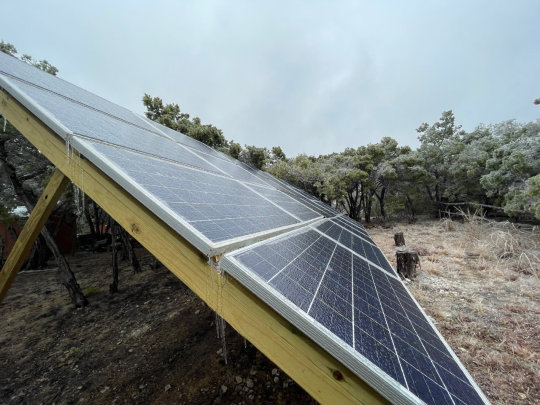#kilowatt-hours
Explore tagged Tumblr posts
Text
Solar Power Eases A Bad Ice Storm

View On WordPress
#charge controller#controller#DIY#electric kettle#hill country#kilowatt#kilowatt-hours#kWh#off-grid#panel#solar#space heater#storage#tankless#toaster oven#update#water heater#wood stove
1 note
·
View note
Text

Love me some pirate-ninjas
#the martian#andy weir#mark watney#kilowatt-hours per sol#pirate-ninjas#my reposted memes#fucking autocorrect#i hate posting on my phone
203 notes
·
View notes
Text
I love how Hayward's writing is strong enough to seep into common rhetoric.
"Show them fear"
"Kill your gods"
Things people say without even needing to know where it comes from.
How much change will be spurred by giving people a rallying cry, giving them spite as another path?
50 notes
·
View notes
Text


🙃
#the silt verses#tsv#tsv spoilers#it's only lights#not even people#and only roughly 200 kilowatt hours for each person#i'm fine it's fine
53 notes
·
View notes
Note
I have ‘van-life’ friends who live in vans and have enough power from their roofrack solar to run a larger mini-fridge-freezer combo and a coffee maker in the mornings, and a small blender for breakfast/lunch smoothies, plus lights and laptop/phone charging.
All this is to say, maybe look into van/rv solar systems to power your community fridges?
I did read an article on RV solar systems! It would probably do me some good to look into more, though. I'll definitely do so!
Right now, the group is wanting to start looking into like. Necessary permits and restrictions on what kind of food can go in and that kind of stuff. IDK how necessary it is for the class project itself, but yknow.
I think it would be cool if these solar fridge concepts became reality someday! I just. Am not the person to do it, that's for sure. I'm already feeling overwhelmed with all the information I've researched already, let alone talking about regulations and nonprofit status and tax forms.
#answered asks#ani rambles#out of queue#community fridge#honestly the big thing is im just bad at math#i'll do the math for watt hours to kilowatt hours to kilowatt hours per day to per month to per year#and then read an article thats like 'minifridges burn 6 kilowatt hours a day' even though my previous math said regular fridges#burned like 2 a day or something and I'll be like 'someone is wrong here and there's a good chance its me'#anonymous
8 notes
·
View notes
Text
why do i answer unknown calls??
#they were from an electricity company#i told them i wasn't interested and he was like oh no listen first and then you decide#meanwhile i was in a hurry to go catch the bus#anyway he then started asking me questions about kilowatt-hours and i was like i have no idea bro im not the one handling this#bc i am not and also expecting him to hung up#but then he made me give him my moms phone which i did bc idk how to say no to people but as i was telling him he heard one number wrong#and i dint correct him and then i blocked his number#jo says stuff#personal ramblings
2 notes
·
View notes
Text
What’s The Difference Between Kilowatts (kW) VS Kilowatt hours?

Understanding the difference between kilowatts (kW) and kilowatt-hours (kWh) is essential for anyone interested in energy consumption, solar power systems, and electricity bills. While both terms are commonly used in discussions about power and energy, they represent different concepts. In this article, we’ll explore the definitions, applications, and differences between kW and kWh, and how this knowledge can help you manage your energy usage more effectively.
What is a Kilowatt (kW)?
A kilowatt (kW) is a unit of power. Power, in the context of electricity, is the rate at which energy is used or produced. One kilowatt is equivalent to 1,000 watts. This measurement tells us how much energy an appliance or system uses or generates at any given moment.
Key Points about Kilowatts:
Measurement of Power: kW measures the rate of energy consumption or generation.
Instantaneous Value: Represents the power at a specific instant.
Common Usage: Used to rate electrical appliances, solar panels, and generators.
For example, if you have a 2 kW solar panel system, it can produce 2 kilowatts of power under optimal conditions. Similarly, a 1.5 kW heater uses 1.5 kilowatts of power when it is running.
If you’re looking to purchase a New Solar Panel in Sydney, Isolux Solar can be your premier choice! Call 1300 552 452 to get a free quote.
What is a Kilowatt-hour (kWh)?
A kilowatt-hour (kWh) is a unit of energy. It represents the amount of energy used or produced over time. One kilowatt-hour is equivalent to using 1,000 watts of power for one hour. This measurement is commonly used by utility companies to calculate electricity consumption and billing.
Read More: What’s The Difference Between Kilowatts (kW) VS Kilowatt hours?
0 notes
Note
Saw a tweet that said something around:
"cannot emphasize enough how horrid chatgpt is, y'all. it's depleting our global power & water supply, stopping us from thinking or writing critically, plagiarizing human artists. today's students are worried they won't have jobs because of AI tools. this isn't a world we deserve"
I've seen some of your AI posts and they seem nuanced, but how would you respond do this? Cause it seems fairly-on point and like the crux of most worries. Sorry if this is a troublesome ask, just trying to learn so any input would be appreciated.
i would simply respond that almost none of that is true.
'depleting the global power and water supply'
something i've seen making the roudns on tumblr is that chatgpt queries use 3 watt-hours per query. wow, that sounds like a lot, especially with all the articles emphasizing that this is ten times as much as google search. let's check some other very common power uses:
running a microwave for ten minutes is 133 watt-hours
gaming on your ps5 for an hour is 200 watt-hours
watching an hour of netflix is 800 watt-hours
and those are just domestic consumer electricty uses!
a single streetlight's typical operation 1.2 kilowatt-hours a day (or 1200 watt-hours)
a digital billboard being on for an hour is 4.7 kilowatt-hours (or 4700 watt-hours)
i think i've proved my point, so let's move on to the bigger picture: there are estimates that AI is going to cause datacenters to double or even triple in power consumption in the next year or two! damn that sounds scary. hey, how significant as a percentage of global power consumption are datecenters?
1-1.5%.
ah. well. nevertheless!
what about that water? yeah, datacenters use a lot of water for cooling. 1.7 billion gallons (microsoft's usage figure for 2021) is a lot of water! of course, when you look at those huge and scary numbers, there's some important context missing. it's not like that water is shipped to venus: some of it is evaporated and the rest is generally recycled in cooling towers. also, not all of the water used is potable--some datacenters cool themselves with filtered wastewater.
most importantly, this number is for all data centers. there's no good way to separate the 'AI' out for that, except to make educated guesses based on power consumption and percentage changes. that water figure isn't all attributable to AI, plenty of it is necessary to simply run regular web servers.
but sure, just taking that number in isolation, i think we can all broadly agree that it's bad that, for example, people are being asked to reduce their household water usage while google waltzes in and takes billions of gallons from those same public reservoirs.
but again, let's put this in perspective: in 2017, coca cola used 289 billion liters of water--that's 7 billion gallons! bayer (formerly monsanto) in 2018 used 124 million cubic meters--that's 32 billion gallons!
so, like. yeah, AI uses electricity, and water, to do a bunch of stuff that is basically silly and frivolous, and that is broadly speaking, as someone who likes living on a planet that is less than 30% on fire, bad. but if you look at the overall numbers involved it is a miniscule drop in the ocean! it is a functional irrelevance! it is not in any way 'depleting' anything!
'stopping us from thinking or writing critically'
this is the same old reactionary canard we hear over and over again in different forms. when was this mythic golden age when everyone was thinking and writing critically? surely we have all heard these same complaints about tiktok, about phones, about the internet itself? if we had been around a few hundred years earlier, we could have heard that "The free access which many young people have to romances, novels, and plays has poisoned the mind and corrupted the morals of many a promising youth."
it is a reactionary narrative of societal degeneration with no basis in anything. yes, it is very funny that laywers have lost the bar for trusting chatgpt to cite cases for them. but if you think that chatgpt somehow prevented them from thinking critically about its output, you're accusing the tail of wagging the dog.
nobody who says shit like "oh wow chatgpt can write every novel and movie now. yiou can just ask chatgpt to give you opinions and ideas and then use them its so great" was, like, sitting in the symposium debating the nature of the sublime before chatgpt released. there is no 'decay', there is no 'decline'. you should be suspicious of those narratives wherever you see them, especially if you are inclined to agree!
plagiarizing human artists
nah. i've been over this ad infinitum--nothing 'AI art' does could be considered plagiarism without a definition so preposterously expansive that it would curtail huge swathes of human creative expression.
AI art models do not contain or reproduce any images. the result of them being trained on images is a very very complex statistical model that contains a lot of large-scale statistical data about all those images put together (and no data about any of those individual images).
to draw a very tortured comparison, imagine you had a great idea for how to make the next Great American Painting. you loaded up a big file of every norman rockwell painting, and you made a gigantic excel spreadsheet. in this spreadsheet you noticed how regularly elements recurred: in each cell you would have something like "naturalistic lighting" or "sexually unawakened farmers" and the % of times it appears in his paintings. from this, you then drew links between these cells--what % of paintings containing sexually unawakened farmers also contained naturalistic lighting? what % also contained a white guy?
then, if you told someone else with moderately competent skill at painting to use your excel spreadsheet to generate a Great American Painting, you would likely end up with something that is recognizably similar to a Norman Rockwell painting: but any charge of 'plagiarism' would be absolutely fucking absurd!
this is a gross oversimplification, of course, but it is much closer to how AI art works than the 'collage machine' description most people who are all het up about plagiarism talk about--and if it were a collage machine, it would still not be plagiarising because collages aren't plagiarism.
(for a better and smarter explanation of the process from soneone who actually understands it check out this great twitter thread by @reachartwork)
today's students are worried they won't have jobs because of AI tools
i mean, this is true! AI tools are definitely going to destroy livelihoods. they will increase productivty for skilled writers and artists who learn to use them, which will immiserate those jobs--they will outright replace a lot of artists and writers for whom quality is not actually important to the work they do (this has already essentially happened to the SEO slop website industry and is in the process of happening to stock images).
jobs in, for example, product support are being cut for chatgpt. and that sucks for everyone involved. but this isn't some unique evil of chatgpt or machine learning, this is just the effect that technological innovation has on industries under capitalism!
there are plenty of innovations that wiped out other job sectors overnight. the camera was disastrous for portrait artists. the spinning jenny was famously disastrous for the hand-textile workers from which the luddites drew their ranks. retail work was hit hard by self-checkout machines. this is the shape of every single innovation that can increase productivity, as marx explains in wage labour and capital:
“The greater division of labour enables one labourer to accomplish the work of five, 10, or 20 labourers; it therefore increases competition among the labourers fivefold, tenfold, or twentyfold. The labourers compete not only by selling themselves one cheaper than the other, but also by one doing the work of five, 10, or 20; and they are forced to compete in this manner by the division of labour, which is introduced and steadily improved by capital. Furthermore, to the same degree in which the division of labour increases, is the labour simplified. The special skill of the labourer becomes worthless. He becomes transformed into a simple monotonous force of production, with neither physical nor mental elasticity. His work becomes accessible to all; therefore competitors press upon him from all sides. Moreover, it must be remembered that the more simple, the more easily learned the work is, so much the less is its cost to production, the expense of its acquisition, and so much the lower must the wages sink – for, like the price of any other commodity, they are determined by the cost of production. Therefore, in the same manner in which labour becomes more unsatisfactory, more repulsive, do competition increase and wages decrease”
this is the process by which every technological advancement is used to increase the domination of the owning class over the working class. not due to some inherent flaw or malice of the technology itself, but due to the material realtions of production.
so again the overarching point is that none of this is uniquely symptomatic of AI art or whatever ever most recent technological innovation. it is symptomatic of capitalism. we remember the luddites primarily for failing and not accomplishing anything of meaning.
if you think it's bad that this new technology is being used with no consideration for the planet, for social good, for the flourishing of human beings, then i agree with you! but then your problem shouldn't be with the technology--it should be with the economic system under which its use is controlled and dictated by the bourgeoisie.
3K notes
·
View notes
Text
"New York is marking the early achievement of its Climate Leadership and Community Protection Act statutory goal a year ahead of schedule, announcing that 6 gigawatts (GW) of distributed solar have been installed across the state, enough to power more than one million homes.
New York State Energy Research and Development Authority (NYSERDA) president and CEO Doreen M. Harris broke the news onsite at a distributed solar project in New Scotland, NY today. The project, developed by New Leaf Energy and owned by Generate Capital, participates in the state’s Solar for All pilot program with utility partner National Grid, meaning its generation benefits low-income households. The site’s 5.7 MW solar array will generate 6.7 million kilowatt-hours of solar energy annually, powering about one thousand homes.
“New York State has provided a replicable model for others to deliver clean, low-cost renewable energy to more consumers,” asserted Harris. “Our public-private partnerships are the catalysts which have helped us to achieve our 6-GW goal well ahead of target, trailblazing New York’s path to an equitable energy transition.”
Governor Kathy Hochul says this achievement brings New York one step closer to a reliable, resilient, zero-emission grid. The Climate Leadership and Community Protection Act contains goals to generate 70% of the state’s electricity from renewable sources by 2030 and 100% zero-emission electricity by 2040.
“Distributed solar is at the heart of reducing greenhouse gas emissions, expanding the availability of renewable energy, and delivering substantial benefits for our health, our environment, and our economy,” Hochul added.
New York achieving its distributed solar goal of 6 GW has generated approximately $9.2 billion in private investment across the state, according to NYSERDA, creating more than 14,000 solar jobs from engineering to installation. Three years ago, Governor Hochul directed to expand the goal to 10 GW by 2030.
“While we’re incredibly proud of the work and partnerships that have led to this achievement, we’re more excited that it can be repeated and multiplied. With the State’s continued leadership, we’re confident we can get to 10 GW and beyond,” predicts New Leaf Energy director of policy and business development Sam Jasinsk.
The state says it has another 3.4 GW of distributed solar projects already in development, making a 10 GW goal quite feasible.
“Customers and consumers are asking for access to clean energy, and New York state is listening,” Generate Capital Investments managing director Peggy Flannery said. Generate Capital operates 69 projects and counting in New York.
In 2023, New York installed more community solar capacity than any other state. Last year was also the state’s most productive year ever for solar installations, with 885 MW of capacity installed.
In April, NYSERDA was selected to receive nearly $250 million from the United States Environmental Protection Agency (EPA) Solar for All program to enhance New York State’s existing portfolio of solar deployment, technical assistance, and workforce development programs for the benefit of over 6.8 million residents that live in low-income households and disadvantaged communities. As part of the grant funding, the New York State Housing and Community Renewal, the New York City Department of Environmental Protection, and New York City Housing Preservation and Development, will implement new programs that target specific barriers to solar deployment for this population."
-via Renewable Energy World, October 17, 2024
#new york#ny#nyc#solar#solar power#distributed solar#community solar#united states#north american#clean energy#climate action#climate hope#good news#hope
353 notes
·
View notes
Text

Only 4 kilograms of uranium are required to power nuclear submarines for 30 years without refueling. The reactors used in nuclear submarines are based on highly enriched uranium (HEU), which contains 90% or more uranium-235. This enriched uranium can produce a large amount of energy in small quantities.
4-5 kilograms of enriched uranium can power a nuclear submarine for several decades, as nuclear fission reactions produce a tremendous amount of energy. The energy produced by the fission of one kilogram of uranium-235 is equivalent to approximately 24,000,000 kilowatt-hours.
The efficient use of fuel in nuclear reactors and the design of the reactor itself eliminate the need for frequent fuel replacements. Nuclear submarines do not require fuel replacements for 20-30 years, which is a significant technological advantage for their long-term missions.
This is why nuclear submarines have greater autonomy than conventional diesel-electric submarines.
163 notes
·
View notes
Text



i was annoyed by people annoying me on twitter and on here so i did the math myself. you can link to this freely. here's the original article i'm getting my numbers on, which cites its sources;
Is AI eating all the energy? Part 1/2 / GioCities
Training the biggest, meanest AI models like ChatGPT and LLAMA takes up 5 million kilowatt hours, or about the energy expenditure of 500 household-years. This is so much energy! Right? Well I guess, but it's about as much energy as manufacturing 290 cars (not 290 thousand or 290 million - 290).
The thing is that people have really bad intuition about large numbers.




For a different alternative measurement, the cost of training the biggest hugest nastiest ai models in the world is 0.015% the cost of Gaming in the USA. Just the USA!
please consider the things people are telling you and why they might be telling you that. ai is not the monster you have been lead to believe, and if you actually do the monster math (i've done this in various areas) - don't stab me - ai is *more energy efficient by far* than a human doing the same thing, by orders of magnitude. if someone spends thirty minutes in stable diffusion making a picture that would've taken a human artist six hours in photoshop, all things being equal, that's about 5.5 hours of energy use Not Used.
its not the bogeyman! it's not magically burning down the amazon rainforest! do some critical thinking about numbers! thanks
141 notes
·
View notes
Text
The Best News of Last Week
1. ‘It was an accident’: the scientists who have turned humid air into renewable power
Greetings, readers! Welcome to our weekly dose of positivity and good vibes. In this edition, I've gathered a collection of uplifting stories that will surely bring a smile to your face. From scientific breakthroughs to environmental initiatives and heartwarming achievements, I've got it all covered.

In May, a team at the University of Massachusetts Amherst published a paper declaring they had successfully generated a small but continuous electric current from humidity in the air. They’ve come a long way since then. The result is a thin grey disc measuring 4cm across.
One of these devices can generate a relatively modest 1.5 volts and 10 milliamps. However, 20,000 of them stacked, could generate 10 kilowatt hours of energy a day – roughly the consumption of an average UK household. Even more impressive: they plan to have a prototype ready for demonstration in 2024.
2. Empty Office Buildings Are Being Turned Into Vertical Farms

Empty office buildings are being repurposed into vertical farms, such as Area 2 Farms in Arlington, Virginia. With the decline in office usage due to the Covid-19 pandemic, municipalities are seeking ways to fill vacant spaces.
Vertical farming systems like Silo and AgriPlay's modular growth systems offer efficient and adaptable solutions for converting office buildings into agricultural spaces. These initiatives not only address food insecurity but also provide economic opportunities, green jobs, and fresh produce to local communities, transforming urban centers in the process.
3. Biden-Harris Administration to Provide 804,000 Borrowers with $39 Billion in Automatic Loan Forgiveness as a Result of Fixes to Income Driven Repayment Plans

The Department of Education in the United States has announced that over 804,000 borrowers will have $39 billion in Federal student loans automatically discharged. This is part of the Biden-Harris Administration's efforts to fix historical failures in the administration of the student loan program and ensure accurate counting of monthly payments towards loan forgiveness.
The Department aims to correct the system and provide borrowers with the forgiveness they deserve, leveling the playing field in higher education. This announcement adds to the Administration's efforts, which have already approved over $116.6 billion in student loan forgiveness for more than 3.4 million borrowers.
4. F.D.A. Approves First U.S. Over-the-Counter Birth Control Pill

The move could significantly expand access to contraception. The pill is expected to be available in early 2024.
The Food and Drug Administration on Thursday approved a birth control pill to be sold without a prescription for the first time in the United States, a milestone that could significantly expand access to contraception. The medication, called Opill, will become the most effective birth control method available over the counter
5. AIDS can be ended by 2030 with investments in prevention and treatment, UN says

It is possible to end AIDS by 2030 if countries demonstrate the political will to invest in prevention and treatment and adopt non-discriminatory laws, the United Nations said on Thursday.
In 2022, an estimated 39 million people around the world were living with HIV, according to UNAIDS, the United Nations AIDS program. HIV can progress to AIDS if left untreated.
6. Conjoined twins released from Texas Children’s Hospital after successfully separated in complex surgery

Conjoined twins are finally going home after the pair was safely separated during a complex surgery at Texas Children’s Hospital in June.
Ella Grace and Eliza Faith Fuller were in the neonatal intensive care unit (NICU) for over four months after their birth on March 1. A large team of healthcare workers took six hours to complete the surgery on June 14. Seven surgeons, four anesthesiologists, four surgical nurses and two surgical technicians assisted with the procedure.
7. From villains to valued: Canadians show overwhelming support for wolves

Despite their record in popular culture, according to a recent survey, seven in 10 Canadians say they have a “very positive” view of the iconic predators.
Here's a fascinating video about how wolves changed Yellowstone nat'l park:
youtube
----
That's it for this week :)
This newsletter will always be free. If you liked this post you can support me with a small kofi donation:
Support this newsletter ❤️
Also don’t forget to reblog.
1K notes
·
View notes
Text
AI Reminder
Quick reminder folks since there's been a recent surge of AI fanfic shite. Here is some info from Earth.org on the environmental effects of ChatGPT and it's fellow AI language models.
"ChatGPT, OpenAI's chatbot, consumes more than half a million kilowatt-hours of electricity each day, which is about 17,000 times more than the average US household. This is enough to power about 200 million requests, or nearly 180,000 US households. A single ChatGPT query uses about 2.9 watt-hours, which is almost 10 times more than a Google search, which uses about 0.3 watt-hours.
According to estimates, ChatGPT emits 8.4 tons of carbon dioxide per year, more than twice the amount that is emitted by an individual, which is 4 tons per year. Of course, the type of power source used to run these data centres affects the amount of emissions produced – with coal or natural gas-fired plants resulting in much higher emissions compared to solar, wind, or hydroelectric power – making exact figures difficult to provide.
A recent study by researchers at the University of California, Riverside, revealed the significant water footprint of AI models like ChatGPT-3 and 4. The study reports that Microsoft used approximately 700,000 litres of freshwater during GPT-3’s training in its data centres – that’s equivalent to the amount of water needed to produce 370 BMW cars or 320 Tesla vehicles."
Now I don't want to sit here and say that AI is the worst thing that has ever happened. It can be an important tool in advancing effectiveness in technology! However, there are quite a few drawbacks as we have not figured out yet how to mitigate these issues, especially on the environment, if not used wisely. Likewise, AI is not meant to do the work for you, it's meant to assist. For example, having it spell check your work? Sure, why not! Having it write your work and fics for you? You are stealing from others that worked hard to produce beautiful work.
Thank you for coming to my Cyn Talk. I love you all!
237 notes
·
View notes
Text
The world’s largest solar panel image, a horse, was constructed in the Kubuqi Desert of Inner Mongolia, China starting in 2017. This massive pattern was built with 196,320 solar panels and covers nearly 1.4 square kilometers (0.54 square miles). It is part of a larger photovoltaic generation base with an annual output of 4 billion kilowatt hours.
40.295360°, 109.670942°
Source imagery: Google Timelapse / Planet
244 notes
·
View notes
Text
started writing an explainer and then realized I mostly want to say that if you don't know what a kilowatt hour is you should shut the fuck up about energy consumption.
102 notes
·
View notes
Text
compiling information about the kineema, because I'm normal
hi. you may remember me from this post talking about how the kineema doesn't have a hood. I've decided to compile all the *other* info I can get on the kineema and comment on it. hopefully this is okay to read
---
let's start with what I could find on fayde
INTERFACING - With its air-cooled, rear-mounted twelve cylinder compression ignition engine driving the rear wheels through a four-speed manual gearbox, the Kineema is able to reach 100 kilometres per hour in 13.5 seconds. And go on to a top speed of 180 kilometres an hour. YOU - Won't it roll over in the first sharp corner? INTERFACING - The high centre of balance is offset by a large battery bank mounted at the bottom of the cabin, feeding all the auxiliary systems and making the Kineema effectively a mobile power plant.
air-cooled: no radiator. I assume this is what those big heat-sink looking things on sides of the engine are for

compression ignition engine: diesel, no spark plugs (diesel engines are named after a guy, rudolph diesel, so I guess in elysium they didn't do that)
rear wheel drive: this is pretty obvious just looking at the thing
100 kilometres per hour in 13.5 seconds: not very fast acceleration compared to modern cars, but the history of cars in elysium is obviously very different to irl
battery bank: this is the only thing keeping the kineema from tipping backwards onto its ass as soon as you accelerate
YOU - "What's it packing there?" (Point to the engine.) KIM KITSURAGI - "Hundred-and-thirty." INTERFACING - I reckon that's a seven-litre V12 there. ENCYCLOPEDIA - Man, that's got to be a major advancement over the KR18GU engine on the old Coupris 40. YOU - "Wait, hundred-and-thirty what?" KIM KITSURAGI - "Kilowatts," the lieutenant replies laconically.
130 kilowatts: ~174 horsepower
YOU - "That's what..." (Rub your chin.) "... a seven-litre V12?" KIM KITSURAGI - "Seven-point-two. Supercharged." The lieutenant is trying to suppress a smug smile. Unsuccessfully. EMPATHY - Saying these words brings him immense joy.
7.2 litre engine: space inside the cylinders. 7.2L/12 = 600cc per cylinder
supercharged: has a supercharger. forces more air into the engine, powered by the crankshaft (as opposed to turbochargers which are powered by the exhaust)
YOU - Run your fingers over one of the steering levers. COUPRIS KINEEMA - The white suede feels luxurious under the touch and the metal clutch handle so very familiar in your palm... INTERFACING - Your fingers waste no time closing around the handle. Clutch disengaged. Release the handle -- clutch drops -- right foot yearns for the familiar touch of the accelerator pedal. You have synced with the machine's mechanical circulation.
YOU - "A *driver* would wear down their right shoe before the left -- the accelerator is on the right. And remember that abandoned lorry cabin we found?"
steering levers: instead of a steering wheel. not exactly sure how they'd work. I *really* don't want it to have differential steering like a zero-turn mower looking at this video of kim driving it looks like the front wheels are the ones steering
clutch handle: instead of a pedal, the clutch is a handle on one of the levers. seems that accelerator and (probably) brake are still pedals
accelerator is on the right: does everyone left-foot brake??? I guess if the clutch handle is standard then that would make sense
ABANDONED LORRY - The glass on the side windows is tinted and covered with dust. You can barely make out the shape of a seat and two steering levers. [...] YOU - Check the pedals. ABANDONED LORRY - You wedge yourself under the steering-wheel to get a better look. Seems like the few tools lying around here -- a hammer, a pair of pliers, a rusty wrench -- have been casually thrown there by the disorganized driver. ABANDONED LORRY - But one odd detail does catch your eye: A piece of sandpaper has been glued to the throttle.
STEERING WHEEL TYPO
---
alright, let's actually take a look at this thing


two door: the kineema has a single driver's seat and two seats in the back. looks like you'd need to move the front seat forward to let anyone else in
suspension: the back wheels look like they have some sort of spring (the axle is connected to it, so how are the wheels being driven??? same with the coupris 40). I assume the front arms also act as a spring
rear view mirror: looks like there's no rear view mirror, since you wouldn't see shit
aerodynamics: bad
seat belts:
¯\_(ツ)_/¯
187 notes
·
View notes